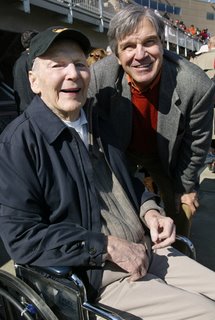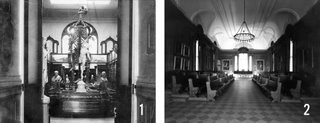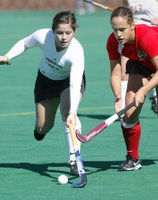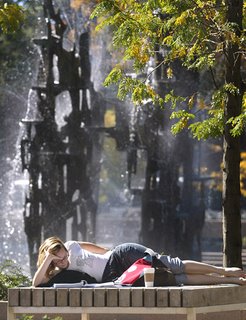Wednesday, October 25, 2006
Investigative journalism and ‘talking-dog cartoons’
The editor of The New Yorker, David Remnick ’81, returned to campus Oct. 18 to talk about his experiences as a writer and editor and the importance of investigative reporting. “Governments frequently lie – that’s what all journalists must confront,” said Remnick, who won a Pulitzer Prize for his book, Lenin’s Tomb: the Last Days of the Soviet Empire. Saying that the Bush White House “is closed like no other,” he said that strong investigative reporting is “a form of social responsibility.” And while it is expensive for media organizations to support such reporting, he said, “the cost of its diminishment is incalculable.”
Remnick’s talk was sponsored by the University Press Club; while at Princeton he wrote for the Press Club and helped found the Nassau Weekly. “I got here and it changed my life,” Remnick told his audience, which filled McCormick 101. He urged would-be writers to “read deeply … to read into a text the way a magician looks at other magicians’ tricks, to see how it’s done.” Editing The New Yorker is “unbelievably fun,” he said, describing his job as being “a professional judge of talking-dog cartoons.” Comparing the magazine’s contents to “a really good buffet table,” he said: “We like to surprise you every week.”
Fans and friends
Josh Billings ’33, left, who captained Princeton’s football team his senior year, and Stas Maliszewski ’66, an All-American guard for the Tigers, were on hand at Princeton Stadium Oct. 21 as the Tigers beat Harvard, 31-28. Billings has vision problems, so Maliszewski provides him with the play-by-play information. Billings, who uses a wheelchair because of post-polio syndrome, says Maliszewski keeps him better informed than if he were watching the game himself.
Photo by Frank Wojciechowski
A run in the park
Princeton’s men’s and women’s cross country teams will eye the top prizes at the Ivy League Heptagonal Championships Oct. 27 at Van Cortlandt Park in the Bronx. Both Tiger squads led the Ivy teams competing at the Pre-Nationals Invitational in Terre Haute, Ind., Oct. 14. The women, ranked as high as No. 7 nationally earlier this season, have not won the Heps title since 1980. “I guess we’re the favorite, which is a place we’re not used to being in,” coach Peter Farrell said in an Ivy League release. “As always, this meet will have some great competition, and we expect a tough race. It’s the Heps.”
In other sports action this week, the undefeated Princeton football team travels to Cornell for a 1 p.m. game Oct. 28 (radio: WBUD, 1260-AM, Trenton); women’s volleyball hosts Harvard Oct. 27 at 7 p.m. and Dartmouth Oct. 28 at 4 p.m. at Dillon Gym; and on Lake Carnegie, the Princeton men’s and women’s crews will compete in the three-mile Princeton Chase Oct. 29.
Said ’57 on screen
Edward Said ’57, the late scholar, Columbia University professor, and advocate of Palestinian independence, is the subject of two independent films released earlier this month in Manhattan. The first, Edward Said: The Last Interview, shows Said in a question-and-answer format, speaking with journalist Charles Glass about his life, his teaching, and his work for the Palestinian cause. Out of Place, the second film, draws its title from Said’s 2000 memoir of the same name and presents a portrait of Said from his childhood in the Middle East through his adult life in New York. A new volume of Said’s writing was published posthumously earlier this year. On Late Style (Pantheon), released in April, is an exploration of music and literature, two of Said’s most notable interests.
Japan, from earthquake and fire to world war
 In Yokohama Burning: The Deadly 1923 Earthquake and Fire That Helped Forge the Path to World War II (Free Press), Joshua Hammer ’79 provides a minute-to-minute account of the massive earthquake and fire that destroyed Yokohama and most of Tokyo and killed 140,000 people in September 1923. He places the events into social and political context and argues that the calamity jumpstarted Japan’s descent into militarism and imperialism. Hammer is a former Newsweek correspondent and author of A Season in Bethlehem. For information about other books by alumni and faculty, visit New Books at PAW online.
In Yokohama Burning: The Deadly 1923 Earthquake and Fire That Helped Forge the Path to World War II (Free Press), Joshua Hammer ’79 provides a minute-to-minute account of the massive earthquake and fire that destroyed Yokohama and most of Tokyo and killed 140,000 people in September 1923. He places the events into social and political context and argues that the calamity jumpstarted Japan’s descent into militarism and imperialism. Hammer is a former Newsweek correspondent and author of A Season in Bethlehem. For information about other books by alumni and faculty, visit New Books at PAW online.More at PAW Online
Under the Ivy – Belcher Hall is the name Princeton trustees wanted to use for Nassau Hall, Gregg Lange ’70 says, but the namesake was too modest.
On the Campus – Jocelyn Hanamirian ’08 writes that with the four-year colleges coming next fall, room draw will be a lot trickier.
On Education - Jason Kamras ’95, the 2005 National Teacher of the Year, looks back on a year of dialogue about improving public schools.
Posted by Brett Tomlinson, with reporting by Katherine Federici Greenwood, Fran Hulette, and W. Raymond Ollwerther ’71.
Princeton Alumni Weekly
Wednesday, October 18, 2006

Nassau Hall: 250 years of change
Since 1756, Nassau Hall has played a central role in the University’s history, from its early days, when it housed the entire College of New Jersey, to its current function as an administrative hub. “As the University has changed, the building itself has really changed and evolved,” said Richard Smith, curator of a new exhibit celebrating the first 250 years of Nassau Hall, on display at the Frist Campus Center Oct. 21 through Nov. 30.
 Smith, a program administrator in the ecology and evolutionary biology department and the author of Princeton University, a recent volume in Arcadia Publishing’s Campus History Series, said that the faculty room offers a perfect illustration of those changes. Today, with its long pews reminiscent of the British House of Commons, the room seems like a throwback to colonial times. But in the original Nassau Hall, the room was much smaller and served as the prayer hall. The space was expanded after a fire in 1855, converted to a library, and later refashioned to house the University museum (1), with a second-floor gallery and a skylight in the middle. The current faculty room (2) was not built until 1906.
Smith, a program administrator in the ecology and evolutionary biology department and the author of Princeton University, a recent volume in Arcadia Publishing’s Campus History Series, said that the faculty room offers a perfect illustration of those changes. Today, with its long pews reminiscent of the British House of Commons, the room seems like a throwback to colonial times. But in the original Nassau Hall, the room was much smaller and served as the prayer hall. The space was expanded after a fire in 1855, converted to a library, and later refashioned to house the University museum (1), with a second-floor gallery and a skylight in the middle. The current faculty room (2) was not built until 1906. With the new faculty room in place, the museum moved to the east wing of Nassau Hall, on the second and third floors (3). But that space eventually was converted to offices; some offices still contain the ornate columns that stood near the museum’s corners, as Smith found (4).
With the new faculty room in place, the museum moved to the east wing of Nassau Hall, on the second and third floors (3). But that space eventually was converted to offices; some offices still contain the ornate columns that stood near the museum’s corners, as Smith found (4).The exhibit will include archival photos and memorabilia, as well as materials removed from Nassau Hall: a railroad track, used in the ceiling as part of the 1855 renovation; a stolen bell clapper that was confiscated by Public Safety and still carries its “evidence” tag; and an original stone that was lifted out to make space for a class ivy marker.
The trustees chose sandstone instead of the more fashionable brick, Smith said, and the stone was quarried near what is now the intersection of Washington and Faculty roads. The 26-inch thick walls later provided temporary refuge for British troops during the Battle of Princeton and also helped Nassau Hall withstand its two terrible fires, in 1802 and 1855. Said Smith: “They built of the local stone, and it’s because of the local stone that this building is still here.”
Visit the University’s community and regional affairs Web site for a complete calendar of events celebrating the 250th anniversary of Nassau Hall.
Photos courtesy of (1) Historical Society of Princeton; (2) and (3) Princeton University Archives; (4) Denise Applewhite, Office of Communications. Top photo by Brett Tomlinson.

On the scene
Princeton midfielder Sarah Reinprecht '09 pursues the ball against Brown's Rebecca Mondics Oct. 14 in a battle for first place in the Ivy League. The Tigers won, 6-1, to remain undefeated in Ivy play.
Photo by Frank Wojciechowski
Orange and Crimson on an autumn afternoon
Echoes of the fall foliage will dot the green fields of Princeton on Saturday, Oct. 21, as the Tigers take on Harvard in four Ivy League contests, including two that could help decide league championships.
The marquee event is a football clash of undefeated teams at Princeton Stadium (noon, TV: YES Network; Radio: WBUD, AM-1260, Trenton). Princeton will try to contain Clifton Dawson, Harvard’s explosive running back, who has averaged 137 yards per game and scored a league-best 12 touchdowns. So far, Princeton’s defense has excelled, allowing less than 12 points per game, and in five weeks, three Tigers – safety Tim Strickland ’07, cornerback J.J. Artis ’07, and tackle Tom Methvin ’09 – have been honored as the Ivy League Defensive Player of the Week.
Princeton field hockey also faces the Crimson at noon, in Class of 1952 Stadium. A win for the Tigers will clinch at least a share of the Ivy title. Men’s soccer plays Harvard at 4 p.m. at Lourie-Love Field, and women’s soccer completes the day with a 7 p.m. matchup against the Crimson, also at Lourie-Love Field.
Four quarters of Princeton-Harvard football trivia
1. Following a disagreement between Princeton and Harvard in 1926, the two schools did not play against each other for seven seasons. Who replaced the Crimson on the Tigers’ 1927 schedule?
a. Ohio State
b. Penn State
c. Trenton State
2. Dick Kazmaier ’52 set a Princeton single-game record against Harvard in 1950 that still stands. What was it?
a. Most rushing yards
b. Most touchdowns
c. Most yards per play
3. In 1966, Princeton, Harvard, and Dartmouth shared the Ivy League football championship. What was the result of the Princeton-Harvard game that year?
a. Harvard won, 9-7
b. Princeton won, 18-14
c. Princeton and Harvard tied, 7-7
4. When was the last time Princeton beat Harvard at home?
a. 2004
b. 1994
c. 1990
Answers at the bottom of this post.
The sounds of water rising
Cara Reichel ’96 will direct a New York City production of The Flood, a musical about an Illinois community’s struggle against the rising tide of the Mississippi River during the summer of 1993, from Oct. 21 through Nov. 19 at the Chernuchin Theatre, 314 West 54th St. The show features music and lyrics by Reichel and Peter Mills ’95 and will be performed by Prospect Theater, a musical theatre group in New York. Visit Prospect Theater’s Web site for more information.
Football trivia answers
1. a. Ohio State – the Tigers won, 20-0; 2. c. Most yards per play – 16.6 (15 plays, 249 yards); 3. b. Princeton won, 18-14; 4. b. 1994.
Posted by Brett Tomlinson, with reporting by Katherine Federici Greenwood.
Princeton Alumni Weekly
Wednesday, October 11, 2006
One of a kind

“Players & Painted Stage,” the new exhibit of Irish theater books and artifacts from the Leonard L. Milberg Irish Theater Collection that opens at Firestone Library Oct. 13, includes one manuscript that few collectors even knew existed: “The Cooing of Doves,” a never-performed one-act play by Sean O’Casey. Last December, at an auction in Dublin, rare books specialist J. Howard Woolmer purchased the typescript for the Milberg Collection for a price -- 60,000 euros, or about $75,000 -- that drew the attention of both the Irish press and the bidders in the room. Despite the significance of the piece, Woolmer said he was able to remain “very cool” during the bidding. "It’s the first auction I’ve ever been to where I was applauded,” he said. For more information about the collection, see PAW's Sept. 27 feature and Professor Michael Cadden’s related essay.
Image courtesy of the Leonard L. Milberg Collection of Irish Theater
Friday night lights
On Oct. 13, Princeton football will make history, hosting Brown in the Ivy League’s first Friday night game (7 p.m. on ESPNU). The Tigers (4-0, 1-0 Ivy) and the Bears (1-3, 0-1 Ivy) played a tight game in Providence last season, which the Bears won 31-28, helping them to win the league championship for the first time since 1999. The Tigers, ranked 22nd in the Division I-AA national coaches' poll, have had a 10-year Ivy title drought and are hoping that a win will propel them to similar success.
Two other Princeton teams also have important Ivy home games this weekend. In field hockey, the Tigers (6-5, 4-0 Ivy) host Brown (7-2, 3-0 Ivy) Oct. 14 at noon at the Class of 1952 Stadium in a game that will determine the front-runner in the league title chase. Women’s volleyball (12-1, 2-1 Ivy) faces defending Ivy champion Cornell (8-6, 3-1 Ivy) Oct. 14 at 4 p.m. in Dillon Gym in a key early-season match.
Rise and fall of an American dynasty

In The Senator and the Socialite: The True Story of America’s First Black Dynasty (HarperCollins), Lawrence Otis Graham ’83 chronicles three generations of a black family, following its members from rags to riches to welfare. The biography focuses on Blanche Kelso Bruce, who was born a Mississippi slave in 1841 and later amassed a real estate fortune, served in the Senate, and married Josephine Willson, the daughter of a wealthy black doctor. By 1950 the family had gone bankrupt after decades of lavish spending and bad investments, and the senator’s grandson was jailed for embezzlement. Graham is a lawyer and author of Our Kind of People: Inside America’s Black Upper Class. For information about other books by alumni and faculty, visit New Books at PAW online.
For brevity's sake
Daniel Oppenheimer, assistant professor of psychology and public affairs, received the 2006 Ig Nobel Prize for Literature Oct. 5 for his research about the unnecessary use of long words. The prizes, which Nature has affectionately called “silliness awards,” are presented at Harvard University by the Annals of Improbable Research. Oppenheimer’s one-line acceptance speech: “Conciseness is interpreted as intelligence, so thank you.” Visit the PAW archives for a brief synopsis of his award-winning work.

On the scene
Good day sunshine: At right, Elizabeth Gummerson, a first-year Ph.D. student at the Woodrow Wilson School, took advantage of the summer-like weather Oct. 9 to hit the books by the fountain next to Robertson Hall.
Photo by Frank Wojciechowski
Alumni in the news
First Lt. Pete Hegseth ’03, a former infantry platoon leader for the 101st Airborne Division, published an op-ed piece in the Wall Street Journal Oct. 3 urging President Bush to send more troops to Iraq. “I believe, as the president noted, that ‘the safety of America depends on the outcome of the battle in the streets of Baghdad,’ ” Hegseth wrote. “Why then do we have just enough troops in Iraq not to lose?” … Former Secretary of State James Baker III ’52 addressed Iraq as well in Time’s “10 Questions” Oct. 9. Baker is co-chairman of the Iraq Study Group, which he said aims “take a fresh-eyes look at the situation in Iraq to see if we can come up with a consensus, a bipartisan approach, and advice to the Congress and the administration.” … The Oct. 9 issue of Time also featured alumnus Tom Szaky '05, the young entrepreneur who, with Jon Beyer ’05, founded TerraCycle, a company that uses worms to turn garbage into plant food. TerraCycle's alumni connections were featured in PAW last April. ... Former Princeton soccer standout Charlie Stillitano ’81 is co-hosting a pair of soccer programs on Sirius satellite radio, The Star-Ledger (Newark, N.J.) reported Sept. 26. The radio shows, which cover European soccer for an American audience, are an uncommon commodity according to Stillitano, the former general manager of the New York-New Jersey Metrostars. “It’s not like the NFL, which you can get at 100 different outlets,” he told the paper. “This is something you can’t easily get. I believe there’s an audience out there.”
More at PAW Online
Under the Ivy - Spelman Halls? Whitman College? Gregg Lange ’70 takes a look around at campus building-naming trends.
On the Campus Online – When it’s time to select a course or proofread a thesis, students can find help from their peers, writes Christian R. Burset ’07.
Eliminating early decision – Dean of Admission Janet Rapelye discusses Princeton’s recent choice in an extended interview.
Posted by Brett Tomlinson, with reporting by Katherine Federici Greenwood.
Princeton Alumni Weekly
Wednesday, October 04, 2006
PAW Update:
Princeton alumnus and journalist R.W. Apple Jr. '57 died this morning in Washington, D.C., according to The New York Times, the newspaper for which he wrote since the 1960s. In 2004, PAW's Mark Bernstein '83 interviewed the venerable writer about his varied interests, his career, and his time as a Princeton undergraduate. Of the latter, Apple said: "I got a tremendous education. I learned to love things. I learned to ask questions. All of which I’ve carried through my whole life." To read the entire interview, click here.
Also available online: Apple's New York Times obituary, written by Todd Purdum '82. (Registration required)
R.W. Apple Jr. '57 dies at age 71
Princeton alumnus and journalist R.W. Apple Jr. '57 died this morning in Washington, D.C., according to The New York Times, the newspaper for which he wrote since the 1960s. In 2004, PAW's Mark Bernstein '83 interviewed the venerable writer about his varied interests, his career, and his time as a Princeton undergraduate. Of the latter, Apple said: "I got a tremendous education. I learned to love things. I learned to ask questions. All of which I’ve carried through my whole life." To read the entire interview, click here.
Also available online: Apple's New York Times obituary, written by Todd Purdum '82. (Registration required)
Posted Oct. 4, 2006 by Brett Tomlinson.

On the scene
Jordan in concert: Jazz guitarist Stanley Jordan '81 performs Sept. 30 in Richardson Auditorium. Jordan's concert was the concluding event of "Coming Back and Looking Forward," a University conference for black Princeton alumni.
Photo by Frank Wojciechowski
Soccer rivals, baseball history
Princeton women’s soccer renews its rivalry with Rutgers in Piscataway, N.J., Oct. 4 at 8 p.m. The game will be broadcast live on Fox Soccer Channel. Princeton, led by Diana Matheson ’08, has started the season 4-4-1. After one-goal losses to Yale Sept. 23 and Dartmouth Sept. 30, the Tigers are anxious to return to their winning ways, but the Scarlet Knights, 9-1-1 this season, are off to their best start in program history.
On Oct. 7, alumnus Chris Young ’02 likely will become the first Princetonian to play in Major League Baseball’s postseason. The 6-foot-10-inch righthander is slated to be the starting pitcher for the San Diego Padres in game three of their National League playoff series with the St. Louis Cardinals (4 p.m. on ESPN).
Tiger tunes: New music from alumni artists
 Emily Tepe ’00 recently released her first CD, IVA. Tepe, who signed with a small production and management company, Vurse, describes her music as “electric-organic-operatic-pop.” Last year she moved to Sweden on a Fulbright Scholarship for performing artists and had been training as a classical opera singer before shifting to her new sound. Click here to buy or listen to her music.
Emily Tepe ’00 recently released her first CD, IVA. Tepe, who signed with a small production and management company, Vurse, describes her music as “electric-organic-operatic-pop.” Last year she moved to Sweden on a Fulbright Scholarship for performing artists and had been training as a classical opera singer before shifting to her new sound. Click here to buy or listen to her music. Sandra Grace Susino ’95 has released her new CD, Do You Have a Lover?, which she describes as a “good work-out album: electronica with dance and progressive house influence, and a pop ballad snuck in for cool-down.” She is donating part of the proceeds to breast cancer research and awareness. Click here for more on Susino and her music.
Sandra Grace Susino ’95 has released her new CD, Do You Have a Lover?, which she describes as a “good work-out album: electronica with dance and progressive house influence, and a pop ballad snuck in for cool-down.” She is donating part of the proceeds to breast cancer research and awareness. Click here for more on Susino and her music.Game, Set, math
Sophomore Aaron Potechin was introduced to the card game Set a year and a half ago by a friend at Columbia who was writing his senior thesis about the game’s mathematics. Set uses a deck of 81 unique cards with four attributes –- color, shading, shape, and number –- and players try to group related sets of three. (For a complete explanation and a demonstration, visit the game’s Web site.)
Potechin was immediately hooked, both to playing the game and deciphering its underlying probabilities. He answered questions such as the average number of sets in a group of 12 cards (2.7) and the maximum number of cards one can deal without having a related set (20). From there he moved on to affine geometry, envisioning the game in a series of vectors. On Sept. 29, he presented his findings, which he hopes to publish, in front of about 30 colleagues in Princeton’s math club.
Understanding the math behind Set does not make Potechin a better player, he said, but it does help him to appreciate the “elegance” of the game. Said Potechin, who is also an avid bridge player: “The probabilities in bridge? I’m not sure there’s much to say about them. With Set, there’s some pretty cool math.”
Joining the club
Edward A. Woolley ’51’s new book, Princeton Prospect Cooperative Club: A Great Social Experiment (Sheepfold Press), provides a history of the liberal undergraduate eating club that existed from 1941 to 1959. Woolley, who was the club president for a year, outlines the mission and objectives of the student members. The club consisted of more public high school graduates than prep school graduates, had more scholarship students than those who paid full tuition, and was the first Princeton eating club with African-American members. For information about other books by alumni and faculty, visit New Books at PAW online.
More at PAW Online
PAW Online has added new features to its Memorials section. The listings have expanded, with memorials now dating back to 1989, and the format for searching memorials has changed. Memorials can now be searched by name, using the search box on the memorials page. In addition, memorials still can be searched by class year, but the names are presented using a new format that no longer requires scrolling through the entire list of names for a given class. To see the new features, view Memorials at PAW Online.